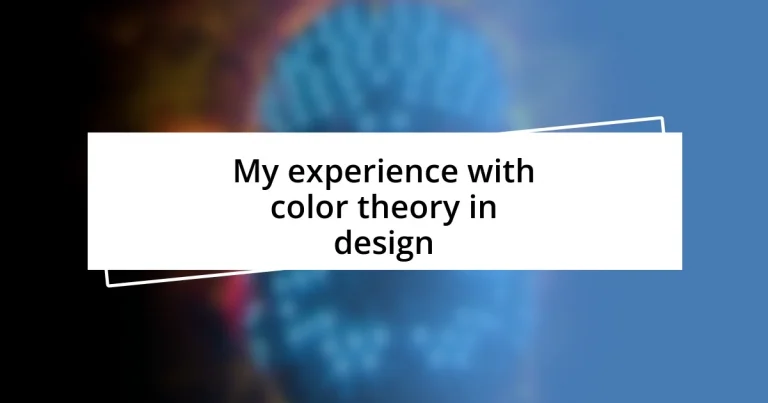Key takeaways:
- Understanding the emotional impact of colors is crucial in design, as they can shape audience experiences and communicate brand values effectively.
- Utilizing different color models (RGB, CMYK, HSB, LAB) appropriately for various mediums greatly affects the visual outcome and context of design projects.
- Common mistakes in color usage include overcomplicating palettes, neglecting emotional resonance, and failing to consider accessibility, which can detract from the overall effectiveness of a design.
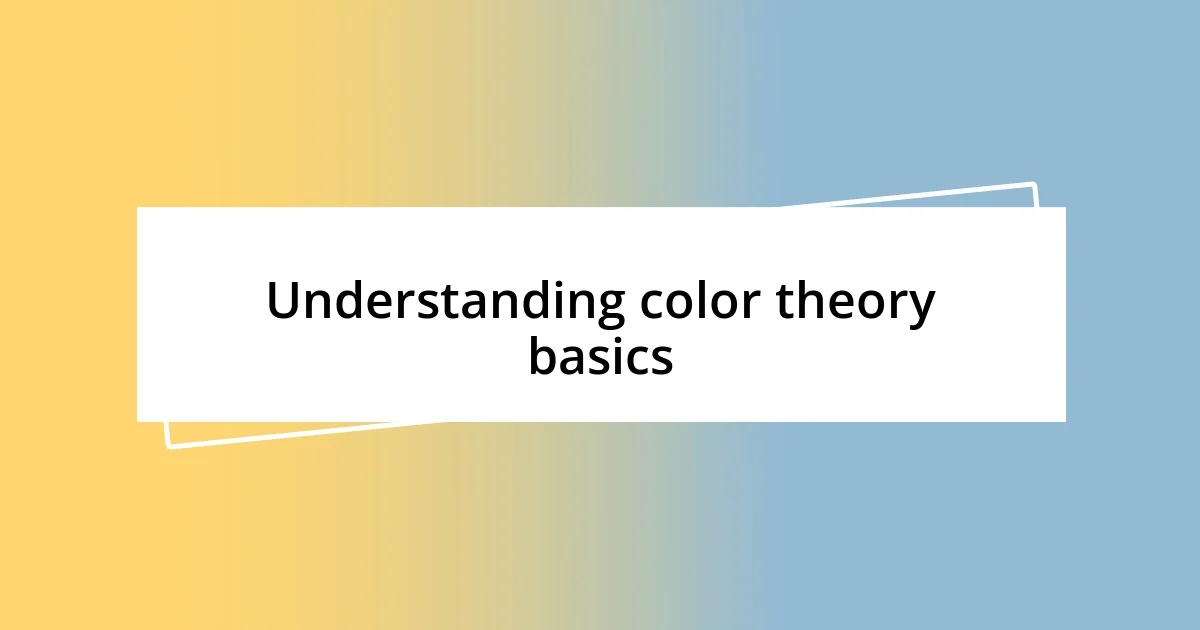
Understanding color theory basics
Color theory is like a guiding compass for designers, offering a foundational understanding of how colors interact and convey emotions. I still remember my first design class when we dove into the color wheel—seeing primary colors blending into secondary ones was like magic to me. Have you ever noticed how a vibrant red can evoke excitement, while a soft blue may bring calmness?
Understanding warm and cool colors is essential, as they elicit different feelings. I often find myself leaning towards warm colors in pieces meant to energize, while cooler tones create a soothing ambiance in my work. It’s fascinating how these subtle choices can change the entire mood of a design.
Then there’s the concept of color harmony, which is vital in creating pleasing visuals. I recall a project where I experimented with analogous colors—neighbors on the color wheel, like blues and greens. The result? A serene landscape that felt immersive and inviting. It made me wonder: how often do we overlook the emotional power of these color combinations in our everyday lives?
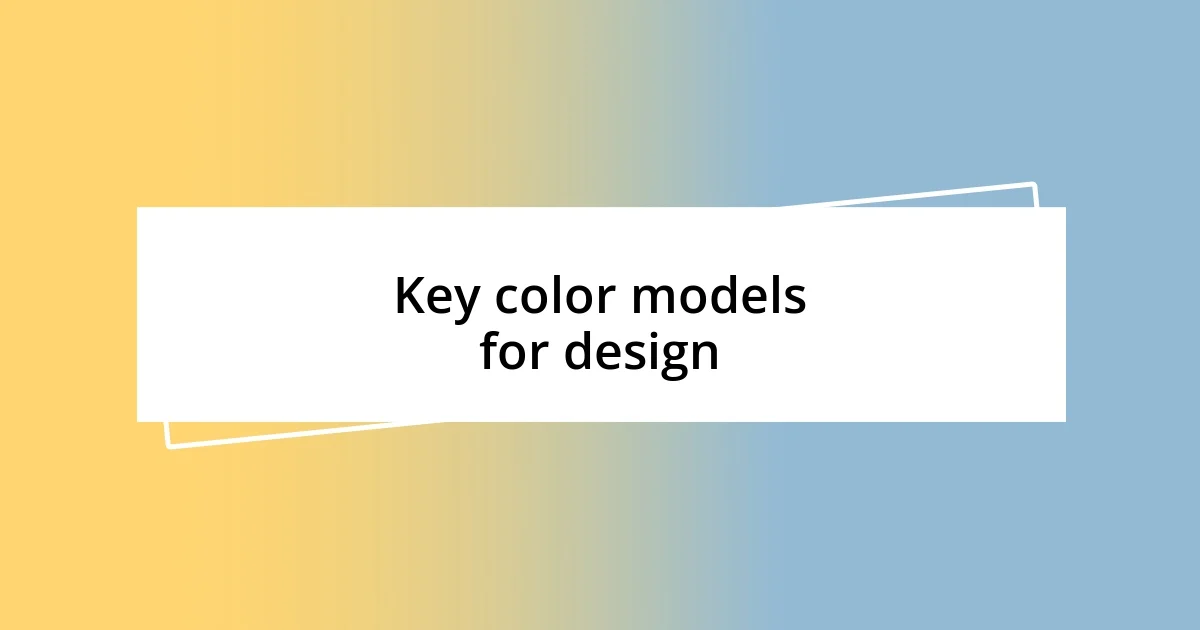
Key color models for design
When diving into key color models for design, I often rely on a few fundamental frameworks that guide my creative choices. The RGB model, for instance, is a staple in digital design, blending red, green, and blue light to create vibrant imagery on screens. I can vividly recall the first time I adjusted an image’s colors using RGB sliders; the ability to see the immediate impact of my choices was exhilarating.
Meanwhile, the CMYK model plays a crucial role in print design, utilizing cyan, magenta, yellow, and black inks. Transitioning between these models has taught me the importance of context in color application. It’s like learning two different languages—each has its own nuances. Here are the key color models I find most essential in my design journey:
- RGB (Red, Green, Blue): Ideal for digital screens; colors are created using light.
- CMYK (Cyan, Magenta, Yellow, Black): Used in printing; blends inks to produce full-color images.
- HSB (Hue, Saturation, Brightness): Focuses on color perception and is useful when adjusting colors to achieve a specific mood.
- LAB: Emulates human vision, providing a way to calibrate colors consistently across mediums.
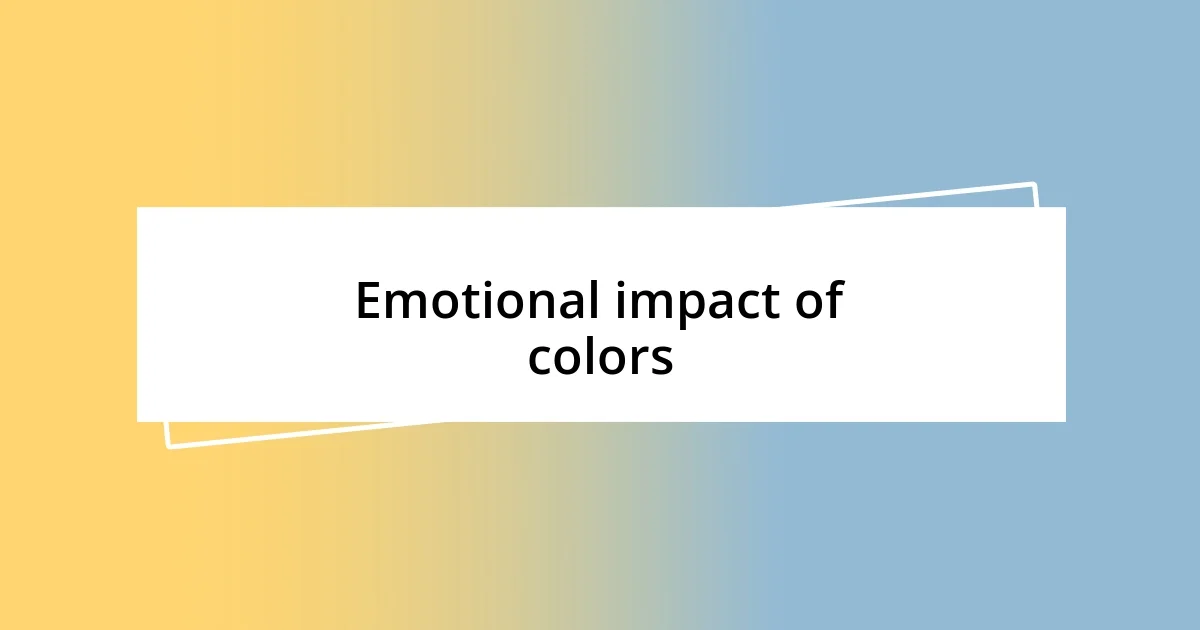
Emotional impact of colors
The emotional impact of colors is something I’ve come to appreciate deeply throughout my design journey. For instance, walking into a room painted in soft yellows instantly lifts my spirits; it feels warm and inviting. In contrast, I’ve noticed that darker hues, like deep purples or blacks, can evoke a sense of melancholy or introspection. Each time I choose a color palette, I think carefully about the feelings I want to elicit from the audience—colors can truly shape their experience.
When I worked on a branding project for a wellness company, I opted for soft greens and blues. This choice resonated with tranquility and rejuvenation, reflecting the brand’s core values. Clients often remark on how certain colors make them feel a certain way; it’s almost as if they’re tapping into an invisible emotional language. Have you ever walked into a café painted in rich browns and oranges? I find that those colors often foster a cozy atmosphere, encouraging conversation and connection.
Color psychology can be astonishingly powerful. In one instance, I tried experimenting with a project using bright reds and yellows, hoping to spark enthusiasm. While the colors were eye-catching, they were also overwhelming, which taught me that the emotional response can vary more than I anticipated. Balancing boldness with comfort is an ongoing learning experience that shapes how I see design altogether.
| Color | Emotional Impact |
|---|---|
| Red | Excitement, Passion |
| Blue | Calmness, Trust |
| Yellow | Happiness, Energy |
| Green | Growth, Harmony |
| Purple | Luxury, Mystery |
| Black | Power, Elegance |
| Orange | Creativity, Enthusiasm |
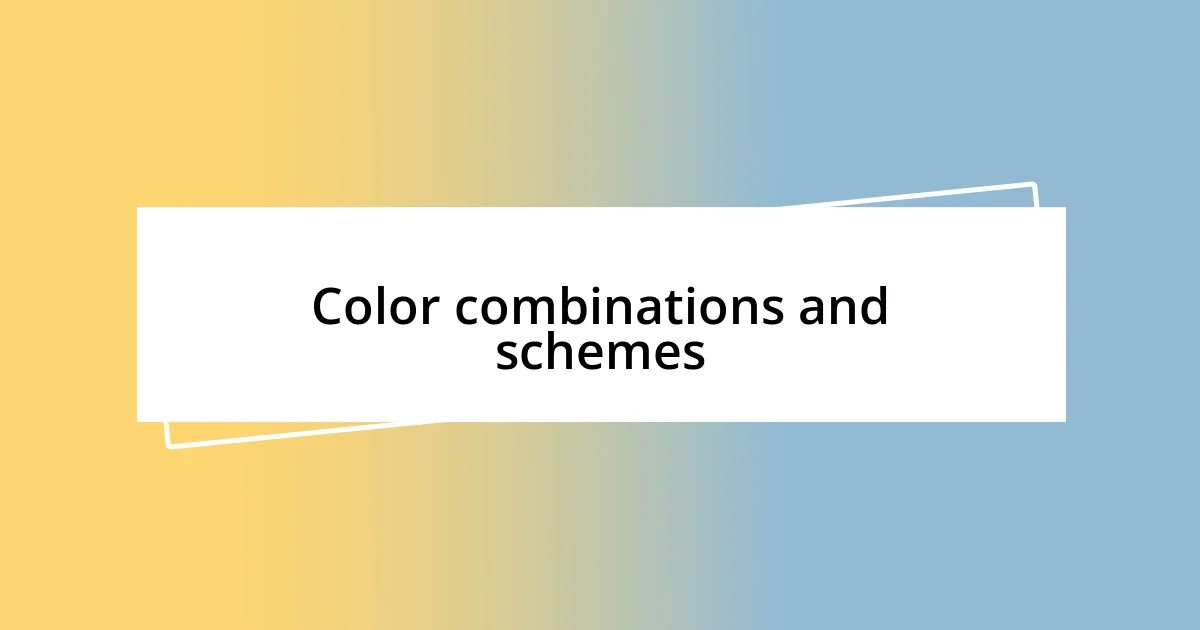
Color combinations and schemes
Color combinations and schemes can feel like a thrilling puzzle to solve. I remember when I was designing a logo and debated between a complementary scheme, which pairs colors directly opposite each other on the color wheel. I chose blue and orange, and the result was stunning—vibrant and attention-grabbing. Have you ever noticed how such combinations can instantly create a visual spark? It’s as if they dance together, drawing the viewer in and making the design pop.
Exploring analogous color schemes, which use colors that sit next to each other on the wheel, is another approach I find captivating. For instance, when working on a nature-themed project, I opted for greens, blues, and teals. This choice mirrored the serenity of the ocean meeting the calm of a forest. The seamless transition between colors made the design feel harmonious, which is something I constantly aim for in my work. There’s a beauty in how closely related colors can create a soothing atmosphere, isn’t there?
I’ll never forget my foray into triadic color schemes—the daring trio of primary colors. In one project, I experimented with red, yellow, and blue, which felt bold and playful. Initially, I hesitated, fearing the colors might clash. But once I strategically balanced their intensity, the outcome was lively and energetic. This taught me a valuable lesson: don’t shy away from vibrant combinations; the right balance can transform an idea into something truly invigorating. What’s your experience with color schemes? I hope my insights spark your creativity!

Practical applications in design projects
When it comes to applying color theory in my design projects, I often find myself thinking about layers. In a recent website redesign for a local restaurant, I used a warm color palette that not only included reds and oranges to evoke appetite but also soft beige accents to create a welcoming vibe. The interplay of these colors brought the brand to life online, and I remember receiving feedback that the site felt as inviting as the restaurant itself. Have you experienced that delightful moment when colors perfectly reflect the essence of a brand?
Additionally, I experimented with saturation levels during a branding project for a tech startup. I opted for muted blues and greens instead of vibrant tones, believing that this would communicate sophistication and reliability. It was fascinating to see how the softened palette captured the essence of innovation while maintaining approachability. Have you ever adjusted color saturation and noticed how small changes can shift the entire mood of a design?
Moreover, when using typography, the choice of color can enhance or detract from readability. I recall a time I designed a poster where I placed bright yellow text on a white background. While it looked cheerful, I quickly realized it was hard to read. I ended up switching to a darker shade that allowed the message to stand out, which reinforced my belief that the right color application is as crucial as the message being conveyed. What have been your challenges with color in typography? Sometimes those little tweaks make all the difference!
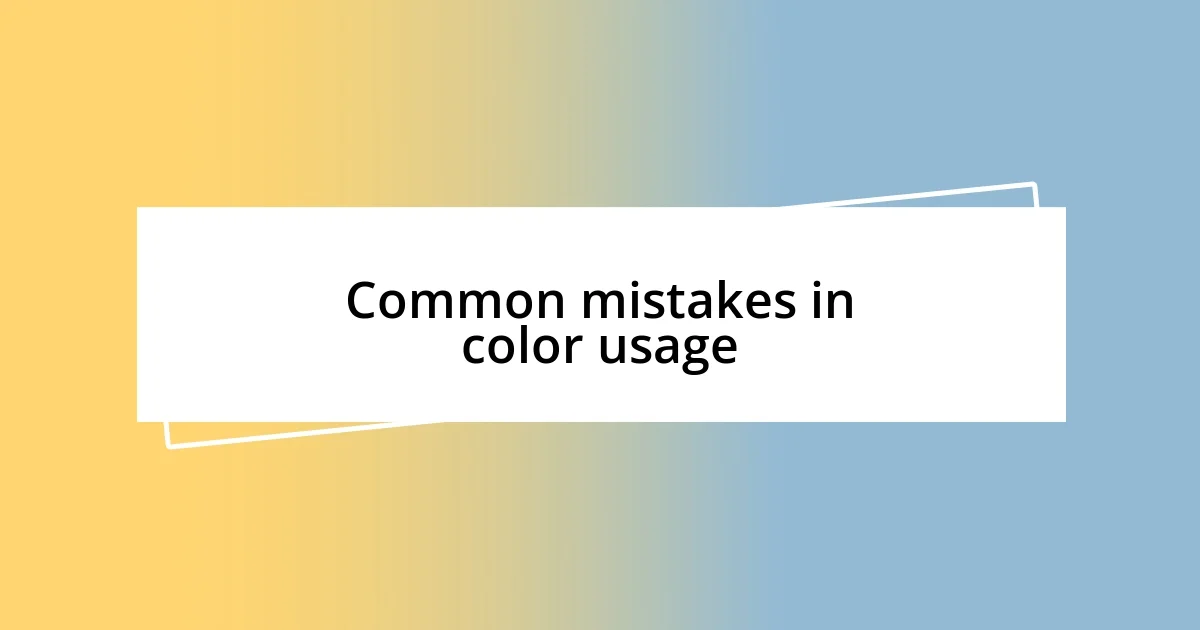
Common mistakes in color usage
One of the biggest pitfalls in color usage that I’ve encountered is overcomplicating palettes. I once worked on a marketing campaign where I was so eager to showcase various colors that I created a chaotic mix that made the design feel overwhelming. It struck me that too many competing colors not only confuse the viewer but can dilute the core message. Have you ever felt your designs were lost in a sea of hues? I learned to simplify and focus on a few key colors that truly resonate with the brand’s identity, making a world of difference.
Another common mistake I see is neglecting the emotional impact of colors. In a personal project involving a charity fundraiser, I initially chose bright, playful colors, thinking they would attract more attention. However, upon reconsideration, I realized that softer, more muted colors would convey compassion and empathy, which are critical for the cause. It’s amazing how a simple color shift can affect the tone of a message. Have you tried adjusting colors to better match the emotions you want to convey? That’s something that sticks with me long after each project.
Finally, one classic oversight involves failing to consider accessibility. I vividly remember designing an infographic for a client and choosing a color scheme that looked great to my eyes but would have been challenging for those with color vision deficiencies. After realizing this, I made sure to check my designs against accessibility guidelines. It’s a crucial step that I now emphasize heavily. Have you thought about how your color choices impact all audience members? It really opened my eyes to the importance of inclusive design practices.
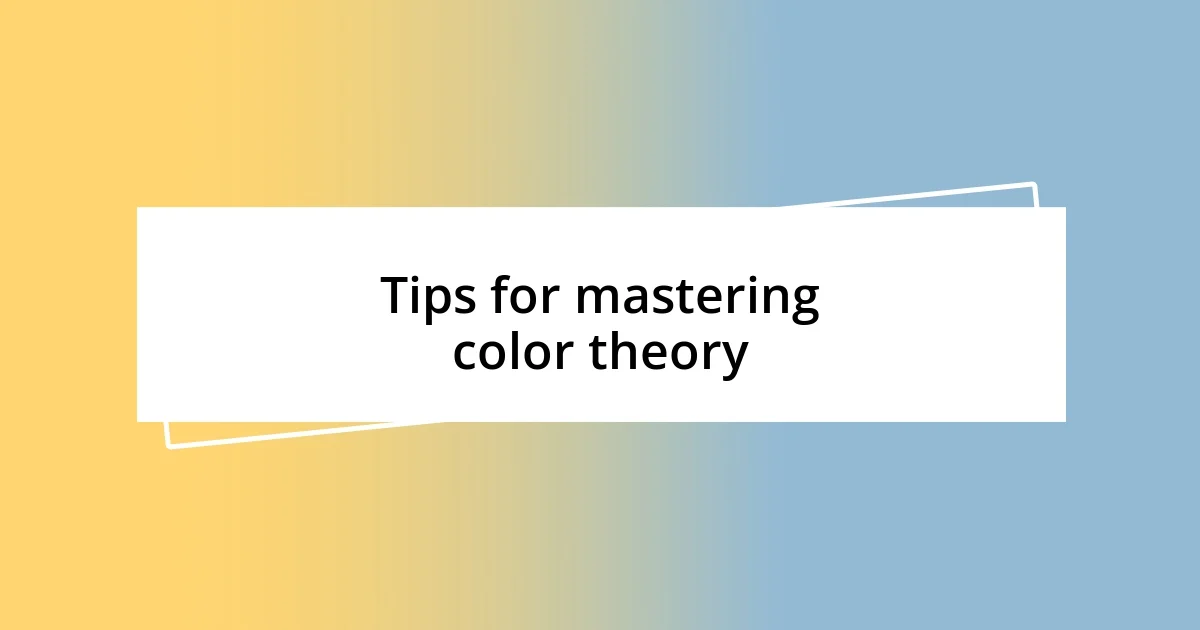
Tips for mastering color theory
Mastering color theory requires a balance between creativity and strategy. One tip I often share is to understand the emotions associated with colors. For instance, during a project for a nonprofit, I chose blues, known for trust and calm, to convey reliability. This choice not only aligned with the mission but also resonated deeply with the target audience. Have you ever thought about what feelings your color choices evoke in others?
Another key aspect is experimenting with different combinations. I remember a project where I paired complementary colors—orange and blue—thinking they would clash, but instead, they created a vibrant and eye-catching visual contrast. This taught me that taking risks can lead to unexpected harmony. Do you often step out of your comfort zone when selecting color schemes?
Lastly, revisiting the classics can be incredibly beneficial. I often turn to classic color theories, like the 60-30-10 rule, where 60% of a space uses a dominant color, 30% a secondary, and 10% an accent. This approach has helped me create balance in my designs. Have you ever tried applying structured color ratios to your projects? It’s surprising how such simple guidelines can elevate the overall aesthetic and impact of your work.












